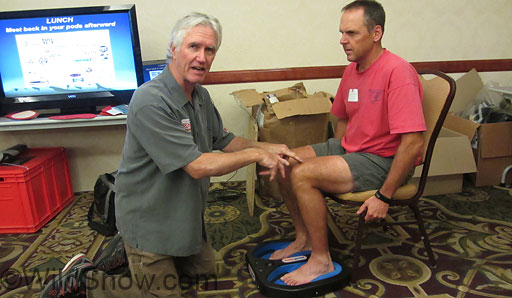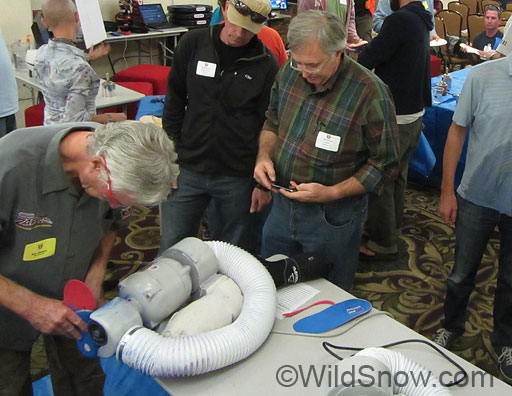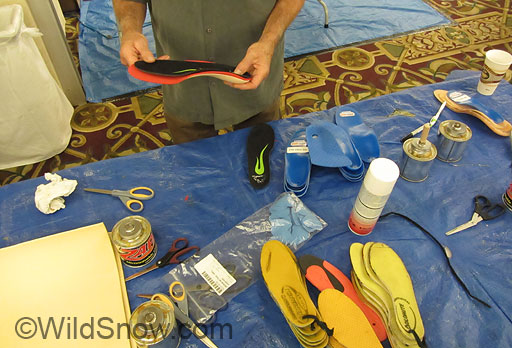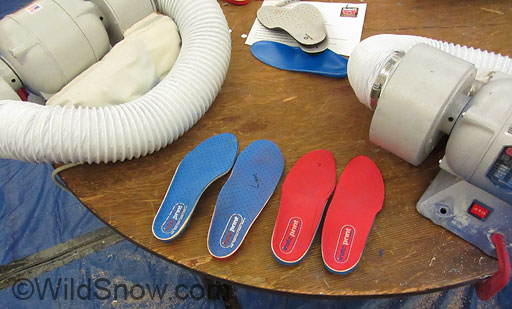
Masterfit University instructor Bob Gleason (Telluride and Taos) literally kicked off the morning. His short anatomy lesson was interesting, but I have to admit the only way I'll really use the terminology he presented is if I spend some time doing rote memorization. To Bob's credit, he did emphasize how medical terms can be useful for precise communication between professionals, but shouldn't be over-used with boot fitting customers.
I’m always fascinated by the way we humans come up with crafts to make our lives easier — and recreation more fun. In the sport of skiing, boot fitting might be the most visible yet most arcane of such things.
Ski tuning isn’t that hard to understand, and it’s often done in a back room, out of sight. Work with a boot fitter, and you’re up front (and I mean up front as in having a person kneeling in front of you messing around with your feet) and personal from the moment you start.
Good snowsport retailers know how meaningful the boot fitting interaction can be — and because of that, how important that it’s done well. Many (I pray most) boot shoppers know this as well. Problem is, as I know first hand, shoppers are not always comfortable with the results or the price of getting their boots customized. Masterfit Enterprises seeks to support the former and remedy the latter, by developing and selling excellent products such as their EZ.FIT drop-in insole (improved for this year, and looking good), as well as operating an extensive seminar operation that builds boot fitting expertise for shop employees and independent boot fitters from Kitzbuhel to Colorado.
We’re loving being here and doing some formal learning about boot fitting. I can already see how my own fitting and custom projects will receive a boost in quality and effectiveness. Good cred for a ski blogger as well. And the boot fitters we do work with will have a much more knowledgeable customer. Indeed, Lisa and I were talking about all this and agreed that any comitted skier with the money and time would receive huge benefit from doing the first level course at Masterfit. For example, if you’ve got fairly normal feet and some knowledge of fitting, you could probably buy and configure your own drop-ins to be nearly as good as an expensive custom job. That sort of thing could be key if you’re running a lot of ski boots and athletic shoes (like us). And who knows? Career number 642?

One thing nice about Masterfit U is they have a specific sub-curriculum for backcountry skiing boots. That was our group, of course. The goal is a '2-finger fit' with solid heel hold, good support, and provision for types of feet and anomalies that you determine through a series of hands-on tests that we're thinking will be incredibly useful back at WildSnow Hq. 'Casting' phase of making footbeds is shown. This isn't rocket science, but neither is it hack work. Basic principles have to be consistently applied, such as leg positions and compensation for foot flexibility, arch height, and that sort of thing.

Foundation of the best boot fitting is the custom footbed (or in some cases a carefully evaluated 'drop-in' bed). A few methods are available on the market and used in various shops, Masterfit's involves a basic foot 'casting' on a gel bed along with a surprising amount of hand crafting (such as working with this grinder).

After today's learning and thinking back on years of boot fitting failures and success, I realized that the many failures I've seen in fitting backcountry skiing boots with custom footbeds has easily been the fault of what the Masterfit guys call 'interfacing.' Meaning the process of matching the footbed to the boot, after it's matched to your foot. From what I experienced, interfacing is significantly more difficult than casting and grinding a footbed. For example, nearly every well known AT boot brand (and many alpine boots) give you a platform (known as boat board or zeppa) inside the boot that is NOT flat. The footbed is molded to work on a flat surface. Thus, if your footbed is not interfaced to an uneven zeppa, likely bummer. In my view, this is where it's mandatory you work with a fitter who regularly deals with AT boots. Otherwise, they'll be perfecting that part of the craft on your dime. Come to think of it, in days past when I did not do my own boot fitting, I can only think of a few times the fitter even looked at the zeppa in my boots.
So, here is a tip for you WildSnowers out there who are working with a boot footer. It’s something you can check for yourself. While the guy is getting your footbeds dialed, he (or she in disturbingly rare cases) should be throwing that footbed in your shell with no liner and doing a tactile check for interface with the boot. Ditto for yourself. Just stick the footbed in the shell, resting on the boot board. Press gently down on the ‘bed and check for rocking or tilting that indicates it’s not shaped to fit the boot. Any lack of interface can cause all sorts of seemingly insurmountable fit problems, since once the footbed is forced to bend and conform to the boot shell, it’s not conforming to your foot.

The couple that beds together stays together. Lisa and mine, first Masterfit footbeds. A bit rough, but they'll work with the correct tweaks.
WildSnow.com publisher emeritus and founder Lou (Louis Dawson) has a 50+ years career in climbing, backcountry skiing and ski mountaineering. He was the first person in history to ski down all 54 Colorado 14,000-foot peaks, has authored numerous books about about backcountry skiing, and has skied from the summit of Denali in Alaska, North America’s highest mountain.
